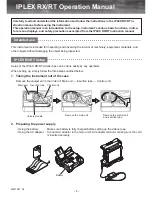
2
1.1
What is ATP?
Adenosine Triphosphate (ATP) is an
organic molecule that is used by living
cells as the main source of energy.
Animal, plant, bacterial, yeast, and mold
cells produce and break down ATP in
order to drive a number of biological
processes. It is the main energy-transfer
molecule in the cell. The presence of ATP on a surface indicates that
the surface has not been adequately cleaned and has the potential
to harbor and support bacterial growth. The residue may also
contain hazardous material including potential allergens. Therefore,
ATP is an ideal indicator of surface cleanliness.
1.2
How Does the Luminometer Work?
The luminometer detects ATP using a chemical reaction.
Luciferin/Luci ATP = Light
A sample is collected using a Hygiena ATP device (see section
1.4
).
Surface tests come with a buffer moistened swab bud that aids in
the removal of any biological material (ATP) on either a wet or dry
surface. Once the sample is collected and exposed to the chemistry
(buffer) in the Hygiena device, the ATP contained inside the
collected cells will be released. ATP released from inside these cells,
along with any free ATP picked up from the surface by the swab, is
now available to react with the chemistry in the bulb of the device.
When the Luciferin/Luciferase enzymes are exposed to ATP, light is
produced. The light is detected and measured by the luminometer.
The amount of light detected is directly proportional to the quantity
of ATP collected and accordingly is proportional to the amount of
residue in the tested sample. The higher the reading, the higher the
amount of contamination in the sample.
1.3
What is an RLU?
The luminometer displays results in Relative Light Unit (RLU) values.
The light produced from the Luciferin/Luciferase and ATP reaction in
the swab is emitted in the form of photons. A photon is an
elementary particle and the basic unit of light. The luminometer
detects these photons and displays them directly as RLU values. The
more light detected by the luminometer, the greater the RLU value.
The quantitative RLU reading is then compared against user
programmable thresholds to provide an overall qualitative pass ,
caution or fail result.
The luminometer detects total ATP, not just ATP from bacteria,
yeast, and mold but also the ATP from anything organic in the
sample. Therefore, an RLU value is not the same as a microbial






































